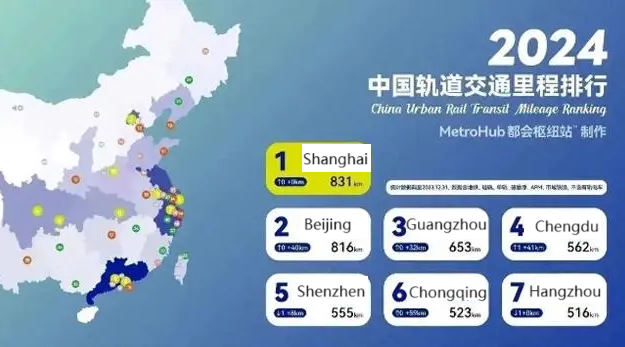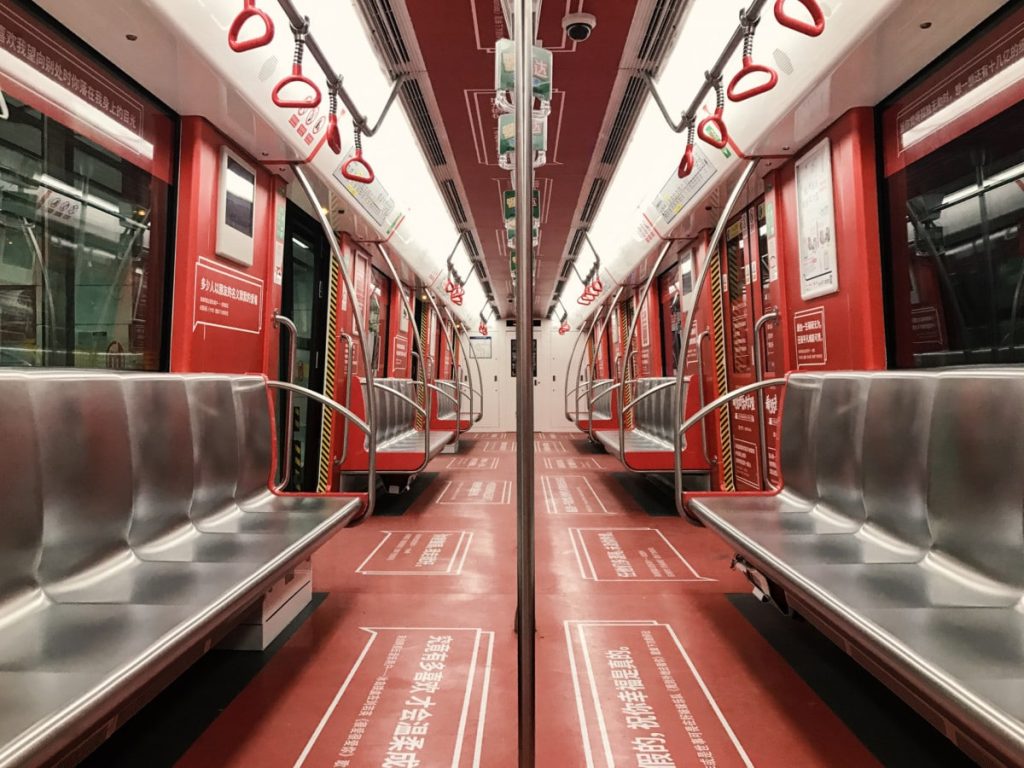Chinese cities with the longest metro (subway) networks often attract international students due to their convenience and efficiency in transportation. Chinese cities known for their extensive metro networks include Shanghai, Beijing, Guangzhou, Chengdu, Shenzhen, Chongqing, Hangzhou.

These cities not only offer extensive metro networks but also provide diverse opportunities for international students due to their vibrant cultural scenes, academic institutions, and economic opportunities.
Shanghai
Shanghai’s extensive subway network is highly beneficial for international students studying in the city. Here are some key points that make the Shanghai subway system attractive to international students:
- Shanghai’s metro network is one of the largest and most extensive in the world, covering 831 kilometers (about 517miles) of track. This extensive coverage ensures that almost every part of the city is accessible via the subway, making commuting convenient and efficient.
- Many of Shanghai’s major universities, including Fudan University, Shanghai Jiao Tong University, Tongji University, and East China Normal University, are well-connected by the metro. This makes it easy for students to travel between their residences and campuses.
- The Shanghai metro is affordable for students, with fares starting at around 3 RMB for short trips and increasing slightly for longer distances.
- Stations and trains in Shanghai typically have signage and announcements in both Chinese and English, which helps international students navigate the system more easily.
- Shanghai’s metro system is known for its safety and cleanliness. Security personnel are present at stations, and the cleanliness of trains and stations is well-maintained, providing a comfortable and secure commuting experience.
- The Shanghai metro integrates well with other modes of public transportation, such as buses and taxis. This interconnectedness offers students flexibility in their commuting options.
Beijing
Beijing subway network is another vital transportation system that greatly benefits international students studying in the city. Here’s why:
- Beijing’s subway system is extensive, covering 816 kilometers (about 507 miles) with multiple lines that connect virtually all parts of the city. This extensive coverage ensures that students can easily access universities, cultural landmarks, and other key areas.
- Beijing subway is known for its efficiency and punctuality. Trains run frequently, especially during peak hours, which helps students commute swiftly and reliably.
- Many of Beijing’s major universities, such as Peking University, Tsinghua University, and Beijing Normal University, are well-served by the subway network. This makes it convenient for students to travel between their accommodations and campuses.
- The fares on the Beijing subway are affordable for students, starting at around 3 RMB for short trips.
- Stations and trains in Beijing typically have signage and announcements in both Chinese and English, which facilitates easier navigation for international students who may not be fluent in Chinese.
- Similar to Shanghai, Beijing subway system maintains high standards of safety and cleanliness. Security personnel are present at stations, and efforts are made to keep trains and stations clean, contributing to a comfortable commuting experience.
- Beijing’s subway system integrates well with other forms of public transportation, such as buses and taxis. This interconnectedness provides students with flexibility in choosing their commuting options based on convenience and cost.
Chengdu
Chengdu subway network, while not as extensive as those in Shanghai or Beijing, is still a valuable asset for international students studying in the city. Here are some key points about the Chengdu subway network and its benefits for international students:
- Chengdu’s subway system has been expanding rapidly in recent years. Chengdu has several operational subway lines covering significant parts of the city, with plans for further expansion to enhance coverage and accessibility.
- Many universities in Chengdu, such as Sichuan University, Southwest Jiaotong University, and University of Electronic Science and Technology of China (UESTC), are accessible via the subway network or are located near subway stations. This makes commuting between campuses, accommodations, and other parts of the city more convenient for students.
- The fares on the Chengdu subway are relatively inexpensive, starting at around 2 RMB for short trips.
- While signage and announcements in Chengdu’s subway stations and trains are primarily in Chinese, major stations and tourist areas often have signage in English as well. This helps international students navigate the system more easily.
- Chengdu’s subway system is generally safe and clean. Security measures are in place at stations, and efforts are made to maintain cleanliness on trains and in stations, providing a comfortable commuting experience for students.
- Chengdu subway integrates well with other modes of public transportation, such as buses and taxis. This interconnectedness allows students to choose the most convenient and efficient mode of transport for their needs.
- Using the subway in Chengdu provides international students with opportunities to explore the city’s rich cultural heritage, vibrant street life, and diverse culinary scene, all of which are easily accessible via the subway network.
Shenzhen
Shenzhen subway network is highly beneficial for international students studying in this rapidly growing metropolis. Here are several reasons why:
- Shenzhen’s subway system has expanded significantly in recent years and continues to grow. As of the latest updates, there are multiple subway lines covering 555 kilometers (about 345 miles) across the city. This extensive coverage ensures that students can easily access universities, commercial areas, and cultural landmarks.
- Many universities in Shenzhen, such as Shenzhen University, Southern University of Science and Technology (SUSTech), and Harbin Institute of Technology (HIT) Shenzhen Graduate School, are conveniently located near subway stations or are accessible via short bus rides from subway stops. This makes commuting to campuses relatively straightforward for students.
- The Shenzhen subway is known for its efficiency and punctuality. Trains run frequently, especially during peak hours, which helps students commute swiftly and reliably throughout the city.
- The fares on the Shenzhen subway are affordable for students, starting at around 2RMB for short trips.
- Signage and announcements in Shenzhen’s subway stations and trains are typically in Chinese and English, which facilitates easier navigation for international students who may not be fluent in Chinese.
- Shenzhen’s subway system maintains high standards of safety and cleanliness. Security measures are in place at stations, and efforts are made to keep trains and stations clean, providing a comfortable commuting experience for students.
- Shenzhen subway integrates well with other forms of public transportation, including buses and taxis. This interconnectedness offers students flexibility in their commuting options based on convenience and cost.
- Many of Shenzhen’s subway stations are equipped with modern amenities such as Wi-Fi, mobile phone charging stations, and barrier-free access, enhancing the overall convenience and accessibility for all passengers, including international students.
Chongqing
Chongqing subway network, although relatively newer compared to those in Shanghai, Beijing, or Shenzhen, still offers significant benefits for international students studying in the city. Here are several reasons why:
- Chongqing’s subway system has been expanding rapidly in recent years. As of the latest updates, there are multiple subway lines covering 523 kilometers (about 325 miles) across the city. The network continues to grow to better serve the city’s growing population and urban sprawl.
- Many universities in Chongqing, such as Chongqing University, Southwest University, and University of Electronic Science and Technology of China (UESTC) Chongqing Campus, are conveniently located near subway stations or have buses connecting directly to subway stops. This makes commuting to campuses relatively convenient for students.
- Chongqing subway is known for its efficiency and punctuality. Trains operate frequently, especially during peak hours, which facilitates swift and reliable commuting for students across different parts of the city.
- The fares on Chongqing subway are affordable for students, starting at around 3 RMB for short trips.
- While signage and announcements in Chongqing’s subway stations and trains are primarily in Chinese, major stations and tourist areas often have signage in English as well. This helps international students navigate the system more easily.
- The Chongqing subway integrates well with other modes of public transportation, such as buses and taxis. This interconnectivity provides students with flexibility in their commuting options and makes it easier to navigate the city.
- Using the Chongqing subway allows international students to explore the city’s unique urban landscape, including its hilly terrain and scenic views along the Yangtze River, which are easily accessible via the subway network.
Hangzhou
Hangzhou subway network is an important transportation asset for international students studying in this dynamic city. Here are several reasons why the Hangzhou subway network is beneficial:
- Hangzhou’s subway system has been expanding rapidly in recent years. As of the latest updates, there are multiple subway lines covering significant parts of the city. The network continues to grow to meet the city’s transportation needs.
- Many universities in Hangzhou, such as Zhejiang University, Hangzhou Normal University, and Zhejiang Gongshang University, are conveniently located near subway stations or are easily accessible by short bus rides from subway stops. This makes commuting between campuses and residential areas more convenient for students.
- Hangzhou subway is known for its efficiency and convenience. Trains run frequently, especially during peak hours, ensuring quick and reliable transportation across various parts of the city.
- The fares on Hangzhou subway are affordable for students, starting at around 2 RMB for short trips.
- Hangzhou’s subway stations and trains typically have signage and announcements in both Chinese and English, which helps international students navigate the system more easily.
- Hangzhou subway integrates well with other modes of public transportation, such as buses and taxis. This interconnectedness offers students flexibility in their commuting options and facilitates seamless travel within the city.
- Using the Hangzhou subway allows international students to explore the city’s rich cultural heritage, scenic West Lake area, and modern urban developments, all easily accessible via the subway network.


